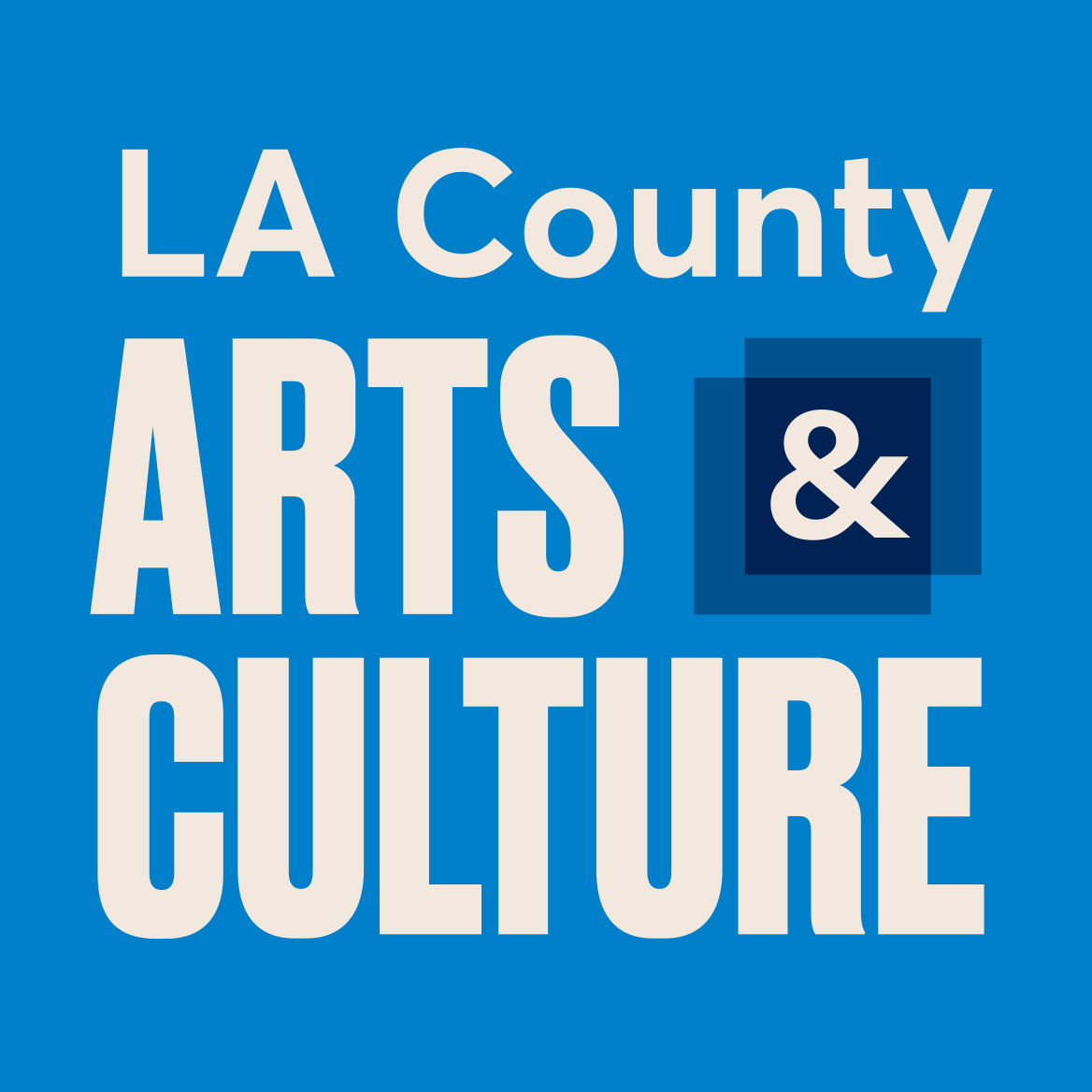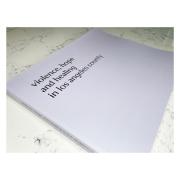Artist Olga Koumoundouros began her residency in 2019 as a Creative Strategist with the newly formed Los Angeles County Office of Violence Prevention (OVP), housed within the Department of Public Health. OVP works to strengthen coordination, capacity, and partnerships to address the root causes of violence, and to advance policies and practices that are grounded in race equity to prevent all forms of violence and to promote healing across all communities in LA County.
During the first year of her residency, Koumoundouros learned about OVP’s work, participated in strategic planning sessions, and engaged with members of OVP’s Community Partnership Council and the Department of Public Health’s Trauma Prevention Initiative. She introduced OVP to trauma-informed, arts-based community engagement methods and employee engagement activities. In collaboration with OVP staff, including Director Andrea Welsing, Koumoundouros developed Violence, Hope and Healing in Los Angeles County: The Storytelling Project, which was designed to humanize the data being collected about violence and to uplift the voices and stories of survivors and those most impacted by violence in its many forms.
Through the art of storytelling, the County would gain a deeper understanding of the many ways violence can have a lasting effect, emotionally and mentally, on individuals who experience it. Stereotypes and assumptions would be challenged. The role systems play in perpetuating cycles of violence would be illuminated, contributing to systems change.

The Storytelling Project Begins
In March 2020, the Office of Violence Prevention and the Department of Arts and Culture both committed resources to accomplish this ambitious project. Koumoundouros’ initial one-year residency was extended, and a research component was added.
This phase of the project–recording the stories of Los Angeles County residents who have experienced violence at the individual or systemic level–launched right at the beginning of the COVID-19 pandemic. This made identifying potential storytellers through OVP’s network of community-based organizations particularly difficult. Koumoundouros persevered, adjusted her approach, and in the end, recorded 100 stories and 54 photographs over a one-year period.
Koumoundouros and OVP staff developed a rubric to ensure stories would reflect a diverse array of perspectives, considering such aspects as geography, age, gender, race/ethnicity, and type of violence. To identify people for the project, Koumoundouros first leaned on relationships she had built with the Community Partnership Council, Trauma Prevention Initiative, and others involved with OVP. Soon, word of mouth and referrals helped Koumoundouros identify others willing to share their story.

Using methods based in oral storytelling traditions, Koumoundouros asked participants to share their experiences with violence, advice they had for others enduring similar experiences, and what they most wanted policy makers to know. She ended each session with a trauma-informed exercise known as the Havening Technique, which helped to ground participants in their current space and time.
Koumoundouros added an artistic element that served to contribute to the humanizing qualities of the project–participants were invited to have their portraits taken, in a location of their choosing, by photographer Johnny Pérez.
The recorded stories were transcribed and edited, with each story being shared back with the storyteller in its written form for final approval. A selection of 33 stories, many with accompanying portraits, were then compiled into the book, Violence, Hope and Healing in Los Angeles County. A digital copy of the book, along with the remaining stories and portraits, is available on this page. The book can be found at LA County Library and other locations.
“Variations in tone, cadence, and non-verbal emotions expanded my understanding of these stories and through the sharing of these narratives, we are given threads that can guide us to accessing our shared humanity. I was so very honored to listen to them all.” –Olga Koumoundouros, about her process
The Social Change Institute, an initiative of Community Health Councils, was contracted to review and analyze 95 of the stories–five additional stories were collected after their analysis was complete–examining and exploring the content for patterns and themes. The process of analyzing the stories surfaced new perspectives and sparked rich conversations.
The Project Expands
Recognizing the opportunity to inspire greater public dialogue and discussion about race, violence, and community solutions to promote equity and inclusion, in 2023, the LA County Anti-Racism, Diversity, and Inclusion (ARDI) Initiative provided funding, through the Equity Fund Spending Plan, to expand the project. In 2024, OVP staff, led by Mia Livas Porter, OVP Policy Analyst, interviewed an additional 43 storytellers. The Department of Arts and Culture once again engaged photographer Johnny Pérez, who made portraits of the storytellers in a location of their choosing. These additional stories, and accompanying portraits, will be available later this year on this site, and eventually, will be published in a second book.
Gatherings for Connection and Reflection
In 2022, and again in 2025, the Department of Public Health Office of Violence Prevention and Department of Arts and Culture, with the Anti-Racism, Diversity, and Inclusion (ARDI) Initiative joining in 2025, co-hosted in-person gatherings of county employees and storytellers at the California Endowment. The events created space for celebration, connection, healing, learning, and reflection. Each celebration provided an opportunity for attendees to hear directly from storytellers, who shared about their participation in the project, their healing journeys, and what they hoped policy makers would learn. These in-person gatherings serve as a meaningful way to commemorate the work and to recognize the invaluable contributions and bravery of these survivors of violence.
Closing Thoughts
The original intention of the project was to use healing-centered arts practices to understand the impact of violence on the lives of our friends, our neighbors, and our communities; better understand where systems had helped or failed individuals; and to identify missing opportunities to intervene, earlier and more effectively. The project was conceived of prior to the COVID-19 pandemic and the murder of George Floyd. Taken together, these pivotal events changed both the context and process of the project and influenced who and why people participated.
What became clear following the first Storytelling Project was the power of trauma-informed storytelling techniques to humanize data, inform public policy, and promote healing. In its second phase, the project aimed to build on that foundation by increasing awareness among policy makers, media, and the public about the impact of violence and trauma and reinforce the message that violence is preventable. The project serves as a model for how government agencies can adopt arts-based, healing-centered practices to tackle complex challenges and support positive outcomes for residents and communities.
If you are interested in sharing your story, please contact ovp@ph.lacounty.gov.
Learn More
Download and read a digital copy of the book.
Explore more stories recorded for the project.
Learn more about the Los Angeles County Office of Violence Prevention.
Learn more about the Creative Strategist program, which places artists in County departments to develop artist-driven solutions to complex civic issues.
About The ArtistS

Olga Koumoundouros is a Los Angeles cultural worker, educator, and researcher dedicated to social justice by creating works that map interconnecting systems of economic, gender, and racial inequities and how they affect people and society. By working with communities and survivors of violence, she works collectively to lift up creative power that strengthens peaceful daily living for all people. As creative strategist for Los Angeles County’s Department of Public Health’s Office of Violence Prevention, she led the Violence, Hope and Healing in Los Angeles County: The Storytelling Project and currently is gaining more tools as a Ph.D. student at the Suzanne Dworak-Peck School of Social Work at USC.

Johnny Pérez is driven by a desire to create connections. As a high school dropout and incarcerated teen, he knows all too well what it is to not matter and lack the confidence to question it. His practice operates in a liminal territory between social practice, education, and public policy. It’s an art practice of healing through affirming his own existence by validating the lives of those who go unseen through interactions and building community. His photography celebrates the capacity of humans to open themselves up to one another. Whether in the sly smile of a stranger on the streets of New York, or the quiet pride in the eyes of a mother in Guatemala, the images act as conduits of emotion, vulnerability, and compassion between artist, subject, and viewer.

Carolina Ibarra-Mendoza is a Xicana graphic designer and visual artist from East LA. She has a double bachelor’s degree from UC Davis in gender studies and design and an MFA in graphic design from Otis College of Art and Design. Her most notable work includes working with Suzanne Lacy and Leslie Labowitz-Starus as the creative strategist and web designer for the feminist archive website AgainstViolence.Art, featured in SF MOMA in 2019.





